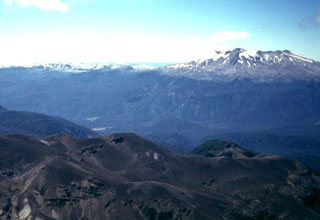Report on Puyehue-Cordon Caulle (Chile) — 15 June-21 June 2011
Smithsonian Institution / US Geological Survey
Weekly Volcanic Activity Report, 15 June-21 June 2011
Managing Editor: Sally Sennert.
Please cite this report as:
Global Volcanism Program, 2011. Report on Puyehue-Cordon Caulle (Chile) (Sennert, S, ed.). Weekly Volcanic Activity Report, 15 June-21 June 2011. Smithsonian Institution and US Geological Survey.
Puyehue-Cordon Caulle
Chile
40.59°S, 72.117°W; summit elev. 2236 m
All times are local (unless otherwise noted)
OVDAS-SERNAGEOMIN reported that the eruption from the Cordón Caulle rift zone, part of the Puyehue-Cordón Caulle volcanic complex, that began on 4 June continued during 15-18 June. The seismic network detected small explosions on 15 June. The eruption plume rose 4-5 km above the crater and drifted SE. The base of the plume was dark gray and ash continued to fall in areas near the volcano. The next day the plume rose 3 km above the crater and was whiter. Satellite imagery showed the plume drifting 1,400 km ESE. On 17 June the plume rose 2 km above the crater and drifted SE. About 5 mm of ash had accumulated in Pajaritos during the night. Ashfall was also reported in eastern areas of Lago Rupanco, about 30 km SSW. According to news articles, plumes from the eruption had circumnavigated the globe, arrived in the W part of Chile (in Coyhaique, 550 km S of the volcano), and again caused domestic flights to be canceled.
On 19 June SERNAGEOMIN noted that meteorological weather prevented clear observations, although a thermal camera used during an overflight showed a thermal anomaly near the emission center. The plume rose 2 km above the crater and drifted SE. A news article stated that authorities lifted the evacuation ban for area residents, allowing them to return home. Articles also stated that flights in South Africa were disrupted during 18-19 June.
SERNAGEOMIN personnel along with regional authorities flew over Puyehue-Cordón Caulle on 20 June. They observed a viscous lava flow with concentric morphology, confirming speculation of magma ascent reflected in seismic data from the previous few days. A 50-m-wide lava flow from the emissions center had traveled 200 m NW and 100 m NE, filling up a depression. A white plume that was gray at the base rose 3-4 km above the crater. Devastated vegetation from pyroclastic flows was observed near the basin of the Nilahue and Abutment rivers. Pulses of tremor were detected by the seismic network. Cameras installed around the volcano showed the plume, which was periodically very dark, rising 5-6 km above the crater. On 21 June the plume rose 3-4 km above the crater and was dark at the base. Although there were no new aerial observations, the seismic signals indicated that the lava flow remained active. News reports noted that flights were again disrupted in parts of Australia on 21 June. SERNAGEOMIN reiterated that the Alert Level remained at 6, Red.
Geological Summary. The Puyehue-Cordón Caulle volcanic complex (PCCVC) is a large NW-SE-trending late-Pleistocene to Holocene basaltic-to-rhyolitic transverse volcanic chain SE of Lago Ranco. The 1799-m-high Pleistocene Cordillera Nevada caldera lies at the NW end, separated from Puyehue stratovolcano at the SE end by the Cordón Caulle fissure complex. The Pleistocene Mencheca volcano with Holocene flank cones lies NE of Puyehue. The basaltic-to-rhyolitic Puyehue volcano is the most geochemically diverse of the PCCVC. The flat-topped, 2236-m-high volcano was constructed above a 5-km-wide caldera and is capped by a 2.4-km-wide Holocene summit caldera. Lava flows and domes of mostly rhyolitic composition are found on the E flank. Historical eruptions originally attributed to Puyehue, including major eruptions in 1921-22 and 1960, are now known to be from the Cordón Caulle rift zone. The Cordón Caulle geothermal area, occupying a 6 x 13 km wide volcano-tectonic depression, is the largest active geothermal area of the southern Andes volcanic zone.
Sources: The Telegraph, Stuff, Servicio Nacional de Geología y Minería (SERNAGEOMIN), Agence France-Presse (AFP), Associated Press

